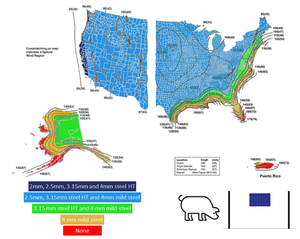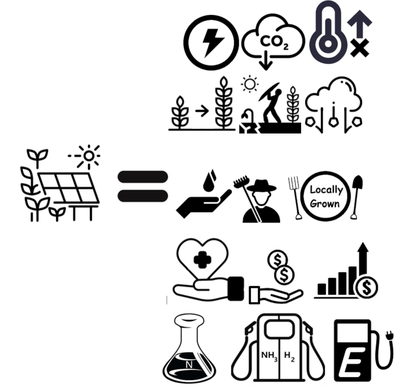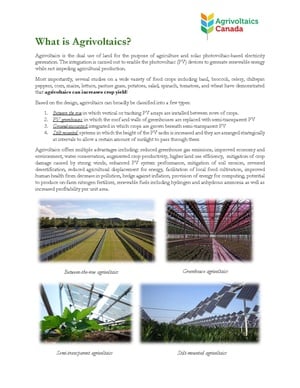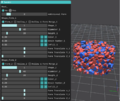
Popular agrivoltaic systems use photovoltaic (PV) farms for pasture grazing animals. In general, these agrivoltaic systems do not reduce the capital cost of a PV farm and in some cases can increase it. To overcome this challenge this study investigates the potential for retrofitting existing animal fencing on farms to have dual use for vertical-mounted monofacial PV racking. Specifically, this study catalogs types of fences and wind load calculations classified under Risk Category I are run through a new python-based Open Source Wind Load Calculator to determine the viability of fence-based racking throughout the U.S. The base shear force for all the fences are calculated for a range of wind loads from 80mph to 150mph (129 km/h to 241 km/h) and the results are mapped to indicate the number of PV modules between the vertical fence poles a fence can tolerate in a specific location. The results show the required fence type including post and battens in a given area for sheep, goats, pigs, cows, and alpaca to be used for agrivoltaics. Overall, at least one PV module between posts is acceptable indicating a new agrivoltaic system potential that as little as $0.035/kWh for racking on existing fencing. Although the yield for a vertical PV can range from 20 to 76 % of an optimized tilt angle depending on azimuth, the racking cost savings enable fence-retrofit agrivoltaics to often produce lower levelized cost electricity. Future work is necessary to determine the full scope of benefits of vertical PV agricultural fencing on a global scale.
Keywords[edit | edit source]
Racking, Frugal engineering, Wind loading, Local materials,Agrivoltaics, fencing; vertical;Sustainable development; Open-source; Photovoltaic; solar energy; balance of systems; renewable energy; do-it-yourself
Open source software[edit | edit source]
Highlights[edit | edit source]
- Retrofitting animal fencing for dual use for vertical-mounted monofacial PV racking.
- Python-based Open Source Wind Load Calculator used for viability throughout the U.S.
- Base shear force mapped for all fences for wind loads from 80 mph to 150.
- Agrivoltaic system potential that as little as $0.035/kWh for racking on existing fencing.
- Racking cost savings make fence-retrofit agrivoltaics a promising new technology.
See also[edit | edit source]
- Optimal inverter and wire selection for solar photovoltaic fencing applications
- To Catch the Sun
- 3-D printable photovoltaic module spacer
- Open source DIY solar photovoltaic racking
- Circular PV panel


- Coal with Carbon Capture and Sequestration is not as Land Use Efficient as Solar Photovoltaic Technology for Climate Neutral Electricity Production
- Dual use of land for PV farms and agriculture literature review
- sheep
- Israeli white plastic reflectors
- A Farmer's Guide to Going Solar (NREL)
- German guidelines: https://www.ise.fraunhofer.de/content/dam/ise/en/documents/publications/studies/APV-Guideline.pdf
- 2021 review
- Miskin, C.K., Li, Y., Perna, A., Ellis, R.G., Grubbs, E.K., Bermel, P. and Agrawal, R., 2019. Sustainable co-production of food and solar power to relax land-use constraints. Nature Sustainability, 2(10), pp.972-980.
- Retrofitting solar parks for agrivoltaics
- Shading PV
- Alexis' talk at American Solar Grazing Association2021
In the News[edit source]
- Agrivoltaics: solar energy + better crops Climate and Nature
- Why solar power and farmers’ fields could be the perfect combination TVO
- Solar farms and sheep show the makings of a clean energy classic duo Business Renewables
- Agrivoltaics charge up St. Albert-area farms St Albert Gazette
- Sheep, solar and crops. How some Alberta farms are creating ideal growing conditions Western Wheel
- Sheep, solar and crops. How some Alberta farms create ideal growing conditions Voxpopuli
- 3D printed clamps for front-surface PV mounting on wood racking PV Magazine
- Harvesting the Sun to Grow in the Shade Garden Culture Magazine
- What crops fit with vertical agrivoltaics? PV Magazine
- Agrivoltaics – Keeping the farm in the solar farm Green Energy Futures
- Solar
- Papers
- Projects
- Agrivoltaics
- Solar power
- Solar energy
- Photovoltaics
- Sustainable development
- Agriculture
- SDG02 Zero hunger
- SDG07 Affordable and clean energy
- SDG09 Industry innovation and infrastructure
- SDG11 Sustainable cities and communities
- FAST Completed
- Electrical engineering
- Energy
- Mechanical engineering
- Wood
- Renewable energy
- DIY






































